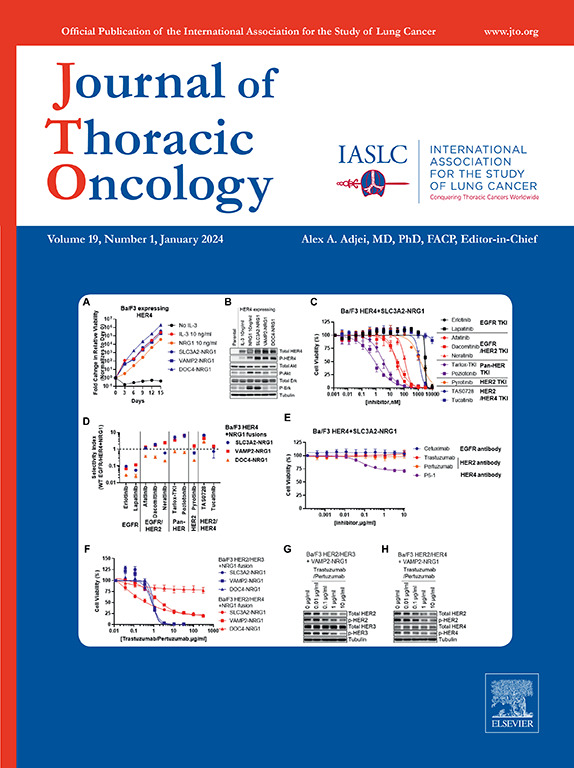LIBELULE:一项随机III期研究,旨在评估可疑转移性肺癌患者早期液体活检的临床相关性。
IF 21
1区 医学
Q1 ONCOLOGY
引用次数: 0
摘要
目的:基因组分析是非小细胞肺癌(NSCLC)患者一线治疗决策的主要组成部分,生物标志物检测的及时性对于改善治疗开始时间(TTI)或避免不适当的治疗至关重要。患者和方法:III期LIBELULE试验(NCT03721120)纳入放射学怀疑为晚期肺癌的患者。他们被随机分配(1:1),对照组根据每个中心的惯例接受诊断程序,液体活检组在第一次就诊时使用InVisionFirst®-Lung检测进行额外的检测。根据ESMO指南确定治疗开始和类型。主要终点是从随机分配到开始适当治疗的时间,基于意向治疗人群的信息基因组和病理结果。结果:共纳入319例患者(LB: 161;控制:158)。中位年龄为68岁,28.8%不吸烟,18.1% PS≥2,56.7%患有腺癌。在LB组,81%的患者有循环肿瘤DNA发现。平均TTI没有显著减少(LB: 29.0天(d);对照组34d (p=0.26))。敏感性分析显示,接受全身治疗的LB组患者TTI较短(LB: 29.1d;对照组:38.8d, p=0.01),晚期非鳞状NSCLC患者(LB: 29.5d;对照组:40.3d, p=0.01),一线靶向性改变患者(LB: 21d;对照组37.4d) (p=0.004)。获得贡献基因组结果的时间显著缩短(LB: 17.9d;结论:早期液体活检对未选择的疑似晚期肺癌患者的TTI无明显缩短作用。然而,它可以减少适合全身治疗的患者的TTI,特别是那些有可操作改变的患者。本文章由计算机程序翻译,如有差异,请以英文原文为准。
LIBELULE: A Randomized Phase III Study to Evaluate the Clinical Relevance of Early Liquid Biopsy in Patients With Suspicious Metastatic Lung Cancer
Objectives
Genomic profiling is a major component for first-line treatment decisions in patients with NSCLC and the timeliness of biomarker testing is essential to improve time to treatment initiation (TTI) or avoid inappropriate treatment.
Methods
The phase III LIquid Biopsy for the Early detection of LUng cancer Lesion trial (NCT03721120) included patients with radiological suspicion of advanced lung cancer. They were randomized (1:1), the control arm receiving diagnostic procedures according to each center’s practice, and the liquid biopsy arm with additional testing performed at the first visit using the InVisionFirst-Lung assay. Treatment initiation and type were defined according to the European Society for Medical Oncology guidelines. Primary endpoint was the time from randomization to initiation of appropriate treatment on the basis of informative genomic and pathological results in the intention-to-treat population.
Results
A total of 319 patients were enrolled (liquid biopsy [LB]: 161; control: 158). The median age was 68 years, 28.8% were non-smokers, 18.1% had a performance status of 2 or higher, and 56.7% had adenocarcinoma. In the LB arm, 81% of patients had circulating tumor DNA findings. The mean TTI was not significantly reduced (LB: 29.0 d; control 34 d (p = 0.26)). Sensitivity analyses found a shorter TTI in patients from the LB arm who received systemic treatment (LB: 29.1 d; control: 38.9 d, p = 0.01), in patients with advanced non-squamous NSCLC (LB: 29.5 d; control: 40.3 d, p = 0.01), and in patients with first-line targetable alterations (LB: 21d; control 37.4 d) (p = 0.004). Time to contributory genomic results was significantly reduced (LB: 17.9 d; control: 25.6 d, p < 0.001).
Conclusion
Early liquid biopsy testing did not significantly shorten the TTI in unselected patients referred for suspected advanced lung cancer. Nevertheless, it could reduce the TTI in patients eligible for systemic treatment, particularly for those with actionable alterations.
求助全文
通过发布文献求助,成功后即可免费获取论文全文。
去求助
来源期刊

Journal of Thoracic Oncology
医学-呼吸系统
CiteScore
36.00
自引率
3.90%
发文量
1406
审稿时长
13 days
期刊介绍:
Journal of Thoracic Oncology (JTO), the official journal of the International Association for the Study of Lung Cancer,is the primary educational and informational publication for topics relevant to the prevention, detection, diagnosis, and treatment of all thoracic malignancies.The readship includes epidemiologists, medical oncologists, radiation oncologists, thoracic surgeons, pulmonologists, radiologists, pathologists, nuclear medicine physicians, and research scientists with a special interest in thoracic oncology.
 求助内容:
求助内容: 应助结果提醒方式:
应助结果提醒方式:


